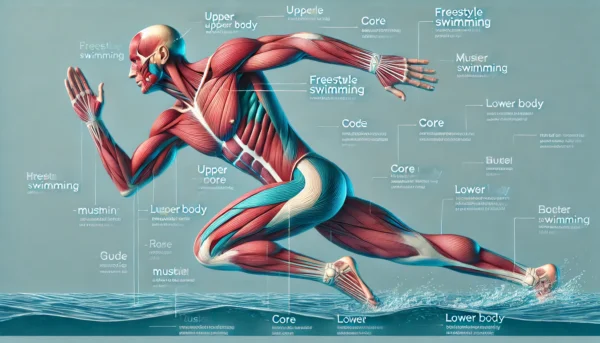Freestyle swimming, often referred to as the front crawl, isn’t just a fast and efficient way to glide through water—it’s a powerhouse of a full-body workout. Whether you’re a beginner or a seasoned swimmer, understanding the muscles involved can help you make the most of this incredible exercise while improving your technique.
The Muscle Groups Engaged in Freestyle Swimming
Freestyle swimming activates nearly every major muscle group in your body. Let’s dive into the details of how each group works to keep you moving through the water.
Upper Body Muscles: The Powerhouse of Propulsion
Your upper body drives you forward in freestyle, making it the most active region during the stroke.
- Shoulder Muscles
- Deltoids: These muscles allow your arms to recover and rotate smoothly, giving you a full range of motion.
- Rotator Cuff: Essential for stabilizing your shoulders, these muscles help prevent injuries from repetitive arm movements.
- Back Muscles
- Latissimus Dorsi (Lats): Often called the “swimmer’s muscles,” your lats provide the powerful downward pull that propels you forward.
- Trapezius & Rhomboids: These muscles work to maintain your posture, ensuring balance as you move.
- Arm Muscles
- Biceps: Active during the pulling phase, helping you generate forward motion.
- Triceps: Engaged during the push phase, adding force as you finish the stroke.
Core Muscles: Your Body’s Anchor
A strong core is key to efficient swimming. It stabilizes your body and ensures smooth energy transfer between your upper and lower body.
- Rectus Abdominis (Abs): Helps maintain a straight, streamlined position in the water.
- Obliques: Facilitate the twisting motion required for an effective stroke.
- Transverse Abdominis: Supports overall stability, making your movements more fluid and controlled.
Lower Body Muscles: The Balance and Propulsion Team
Though your upper body does much of the work, your legs are vital for maintaining balance and contributing to propulsion.
- Hip Muscles
- Hip Flexors: Power the flutter kick by lifting your legs.
- Glutes: Add stability and strength, especially for longer swims.
- Leg Muscles
- Quadriceps: Engage during the upward motion of your flutter kick, keeping your legs straight and efficient.
- Hamstrings: Power the downward kick, helping to drive you forward.
- Calves: Stabilize your ankles for a smooth, streamlined kick.
Maximizing Muscle Engagement
Focus on technique, cross-training, and recovery to make the most of your freestyle workouts.
1. Perfect Your Technique
- Master Your Stroke: A strong pull with your arms activates your lats, triceps, and core for maximum efficiency.
- Stay Streamlined: Tighten your core to reduce drag and glide smoothly through the water.
- Kick with Purpose: A consistent flutter kick powered by your hips and legs maintains balance without wasting energy.
2. Incorporate Dryland Training
Strength training on land complements your swimming workouts and boosts muscle performance.
- Push-ups: Strengthen your chest, shoulders, and triceps.
- Planks: Build core stability for better posture and balance.
- Squats: Target your glutes, quads, and hamstrings.
3. Prioritize Stretching and Recovery
Swimming is a repetitive motion, which can lead to tight muscles. Stretching helps maintain flexibility and prevent injuries. Focus on:
- Shoulders
- Back
- Hips
- Legs
Why Freestyle Swimming is Worth It
Freestyle swimming goes beyond building muscles; it’s a holistic workout with benefits for your body and mind.
- Heart Health: It’s a cardio workout that improves heart and lung function.
- Muscle Toning: Provides a full-body workout to tone and sculpt muscles.
- Stress Relief: The rhythmic motion and soothing nature of water help reduce stress and promote relaxation.
Freestyle swimming isn’t just about speed—mastering a workout that engages your entire body. Whether swimming for fitness, fun, or competition, understanding how your muscles work will help you swim smarter and stronger. So dive in and let the water work its magic on your body!

1 thought on “What Muscles Does Freestyle Swimming Work?”